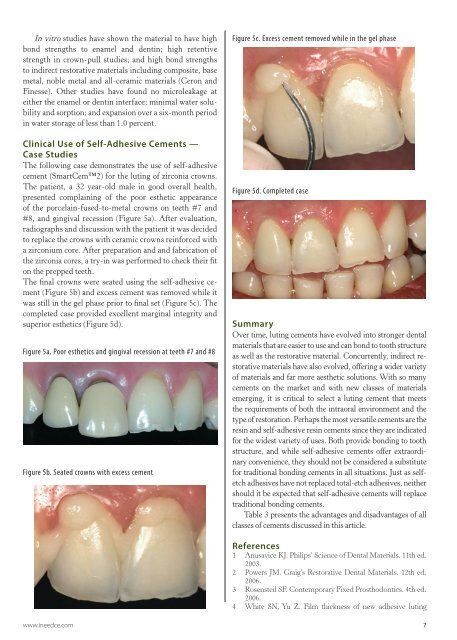A Practical Guide to the Use of Luting Cements - IneedCE.com
A Practical Guide to the Use of Luting Cements - IneedCE.com
A Practical Guide to the Use of Luting Cements - IneedCE.com
You also want an ePaper? Increase the reach of your titles
YUMPU automatically turns print PDFs into web optimized ePapers that Google loves.
In vitro studies have shown <strong>the</strong> material <strong>to</strong> have high<br />
bond strengths <strong>to</strong> enamel and dentin; high retentive<br />
strength in crown-pull studies; and high bond strengths<br />
<strong>to</strong> indirect res<strong>to</strong>rative materials including <strong>com</strong>posite, base<br />
metal, noble metal and all-ceramic materials (Ceron and<br />
Finesse). O<strong>the</strong>r studies have found no microleakage at<br />
ei<strong>the</strong>r <strong>the</strong> enamel or dentin interface; minimal water solubility<br />
and sorption; and expansion over a six-month period<br />
in water s<strong>to</strong>rage <strong>of</strong> less than 1.0 percent.<br />
Clinical <strong>Use</strong> <strong>of</strong> Self-Adhesive <strong>Cements</strong> —<br />
Case Studies<br />
The following case demonstrates <strong>the</strong> use <strong>of</strong> self-adhesive<br />
cement (SmartCem2) for <strong>the</strong> luting <strong>of</strong> zirconia crowns.<br />
The patient, a 32 year-old male in good overall health,<br />
presented <strong>com</strong>plaining <strong>of</strong> <strong>the</strong> poor es<strong>the</strong>tic appearance<br />
<strong>of</strong> <strong>the</strong> porcelain-fused-<strong>to</strong>-metal crowns on teeth #7 and<br />
#8, and gingival recession (Figure 5a). After evaluation,<br />
radiographs and discussion with <strong>the</strong> patient it was decided<br />
<strong>to</strong> replace <strong>the</strong> crowns with ceramic crowns reinforced with<br />
a zirconium core. After preparation and and fabrication <strong>of</strong><br />
<strong>the</strong> zirconia cores, a try-in was performed <strong>to</strong> check <strong>the</strong>ir fit<br />
on <strong>the</strong> prepped teeth.<br />
The final crowns were seated using <strong>the</strong> self-adhesive cement<br />
(Figure 5b) and excess cement was removed while it<br />
was still in <strong>the</strong> gel phase prior <strong>to</strong> final set (Figure 5c). The<br />
<strong>com</strong>pleted case provided excellent marginal integrity and<br />
superior es<strong>the</strong>tics (Figure 5d).<br />
Figure 5a. Poor es<strong>the</strong>tics and gingival recession at teeth #7 and #8<br />
Figure 5b. Seated crowns with excess cement<br />
Figure 5c. Excess cement removed while in <strong>the</strong> gel phase<br />
Figure 5d. Completed case<br />
Summary<br />
Over time, luting cements have evolved in<strong>to</strong> stronger dental<br />
materials that are easier <strong>to</strong> use and can bond <strong>to</strong> <strong>to</strong>oth structure<br />
as well as <strong>the</strong> res<strong>to</strong>rative material. Concurrently, indirect res<strong>to</strong>rative<br />
materials have also evolved, <strong>of</strong>fering a wider variety<br />
<strong>of</strong> materials and far more aes<strong>the</strong>tic solutions. With so many<br />
cements on <strong>the</strong> market and with new classes <strong>of</strong> materials<br />
emerging, it is critical <strong>to</strong> select a luting cement that meets<br />
<strong>the</strong> requirements <strong>of</strong> both <strong>the</strong> intraoral environment and <strong>the</strong><br />
type <strong>of</strong> res<strong>to</strong>ration. Perhaps <strong>the</strong> most versatile cements are <strong>the</strong><br />
resin and self-adhesive resin cements since <strong>the</strong>y are indicated<br />
for <strong>the</strong> widest variety <strong>of</strong> uses. Both provide bonding <strong>to</strong> <strong>to</strong>oth<br />
structure, and while self-adhesive cements <strong>of</strong>fer extraordinary<br />
convenience, <strong>the</strong>y should not be considered a substitute<br />
for traditional bonding cements in all situations. Just as selfetch<br />
adhesives have not replaced <strong>to</strong>tal-etch adhesives, nei<strong>the</strong>r<br />
should it be expected that self-adhesive cements will replace<br />
traditional bonding cements.<br />
Table 3 presents <strong>the</strong> advantages and disadvantages <strong>of</strong> all<br />
classes <strong>of</strong> cements discussed in this article.<br />
References<br />
1 Anusavice KJ. Philips’ Science <strong>of</strong> Dental Materials. 11th ed.<br />
2003.<br />
2 Powers JM. Craig’s Res<strong>to</strong>rative Dental Materials. 12th ed.<br />
2006.<br />
3 Rosensteil SF. Contemporary Fixed Prosthodontics. 4th ed.<br />
2006.<br />
4 White SN, Yu Z. Film thickness <strong>of</strong> new adhesive luting<br />
www.ineedce.<strong>com</strong> 7
















